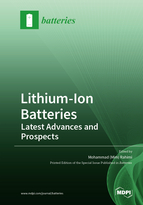Lithium-Ion Batteries: Latest Advances and Prospects
A special issue of Batteries (ISSN 2313-0105).
Deadline for manuscript submissions: closed (31 December 2020) | Viewed by 95535
Special Issue Editor
Interests: electrochemical CO2 capture; waste heat conversion; thermal battery; lithium-ion battery; thermo-electrochemical cells; photocatalysis; membrane separation
Special Issues, Collections and Topics in MDPI journals
Special Issue Information
Dear Colleagues,
Lithium-ion batteries (LIBs), as a key part of the 2019 Nobel Prize in Chemistry, have become increasingly important in recent years, owing to their potential impact on building a more sustainable future. Compared with other developed batteries, LIBs offer high energy density, high discharge power, and long service life. These characteristics have facilitated a remarkable advance of LIBs in many frontiers, including electric vehicles, portable and flexible electronics, and stationary applications. Since the field of LIBs is advancing rapidly and attracting an increasing number of researchers, it is necessary to often provide the community with the latest updates. Therefore, this Special Issue was designed to focus on updating the electrochemical community with the latest advances and prospects on various aspects of LIBs. Researchers are invited to submit their original research as well as review/perspective articles for publication in this Special Issue. Potential topics include but are not limited to:
- Various types of LIBs: LCO, LMO, LFP, LNMC, LNCA, LTO, Li-S, Li-air;
- Developing electrodes, electrolyte, and separators for LIBs;
- Solid electrolyte interface (SEI);
- Modeling of LIBs;
- Battery management systems (BMS);
- Battery life and safety;
- Machine learning applications in LIBs;
- Solid-state LIBs;
- Wearable and flexible LIBs;
- LIBs for electric vehicles.
Dr. Mohammad (Mim) Rahimi
Guest Editor
Manuscript Submission Information
Manuscripts should be submitted online at www.mdpi.com by registering and logging in to this website. Once you are registered, click here to go to the submission form. Manuscripts can be submitted until the deadline. All submissions that pass pre-check are peer-reviewed. Accepted papers will be published continuously in the journal (as soon as accepted) and will be listed together on the special issue website. Research articles, review articles as well as short communications are invited. For planned papers, a title and short abstract (about 100 words) can be sent to the Editorial Office for announcement on this website.
Submitted manuscripts should not have been published previously, nor be under consideration for publication elsewhere (except conference proceedings papers). All manuscripts are thoroughly refereed through a single-blind peer-review process. A guide for authors and other relevant information for submission of manuscripts is available on the Instructions for Authors page. Batteries is an international peer-reviewed open access monthly journal published by MDPI.
Please visit the Instructions for Authors page before submitting a manuscript. The Article Processing Charge (APC) for publication in this open access journal is 2700 CHF (Swiss Francs). Submitted papers should be well formatted and use good English. Authors may use MDPI's English editing service prior to publication or during author revisions.
Keywords
- Various types of LIBs: LCO, LMO, LFP, LNMC, LNCA, LTO, Li-S, Li-air
- Developing electrodes, electrolyte, and separators for LIBs
- Solid electrolyte interface (SEI)
- Modelling of LIBs
- Battery management systems (BMS)
- Battery life and safety
- Machine learning applications in LIBs
- Solid-state LIBs
- Wearable and flexible LIBs
- LIBs for electric vehicles.






